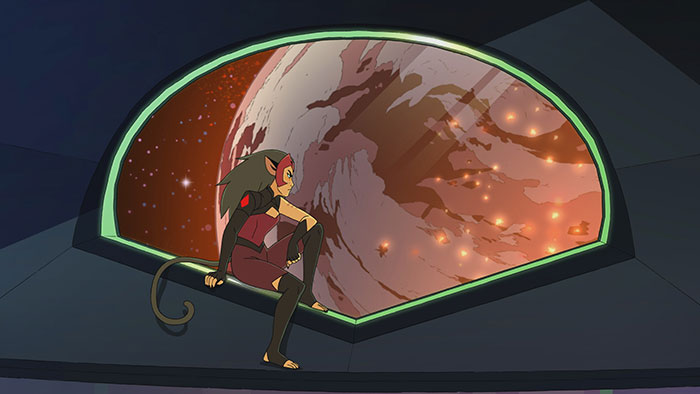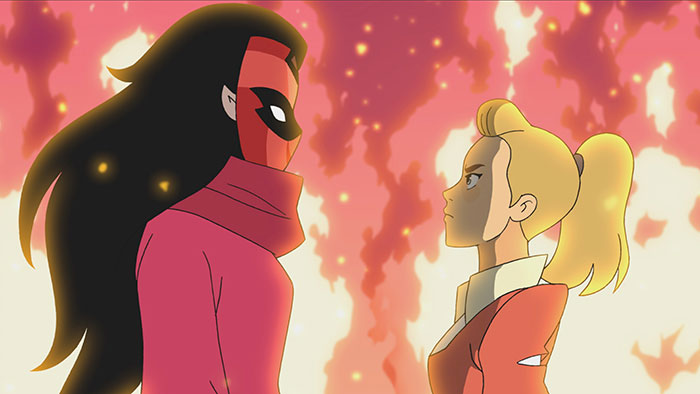As befits the final season – the stakes were great, so was the threat (and at one point it lurked among the people closest to Adora). The heroes made more grand gestures. Even the surroundings gained momentum when the princesses flew into space! It was an interesting operation: confronting the heroes with unknown technology in such a dangerous environment and with Horde Prime lurking in the collective consciousness of those he controlled.
When you get a second chance
The theme of redemption and forgiveness was present on the show from the very beginning. Eventually, Adora herself, raised by the Horde, crossed over to the other side and had to go to great lengths to gain the trust of the rebels. Scorpia followed a similar path, and Entrapta, fascinated by technology, had to understand her behavior and return to her old friends. The fifth season, however, showed even more that everyone can change.

Source: Netflix
I admit that before the premiere of the final series, I did not expect Catra to take another chance at redemption. Until now, she had shunned every opportunity to do so, allowing her to continue to be ruled by anger, a sense of rejection, and extremely low self-esteem. At the same time, throughout the series, we knew that Adora had not finally deleted her childhood friend and she strongly believed that this one was really good. Forgiveness was possible and Catra received it in the final series. But what impressed me most about this transformation is that redemption did not come in the end. Catra had made this choice much earlier, and for most episodes she had to accept that Adora was essentially right and that she herself deserved someone’s friendship and trust, and even love. She also had to look into the faces of those
This wasn’t the only redemption picture we got from Noelle. Shadow Weaver received a noble death for this, but I would be far from stating that her guilt towards Adora and Catra could have been erased. She was a surrogate mother to them, but from the flashbacks we’ve seen, I know she was a hard-hearted and sometimes downright cruel mother. Despite the fact that she helped the rebels in the last fight, almost until the very end she tried to cause a conflict between her former charges.

Source: Netflix
Hordak – the main antagonist to date – joined the rebels, tipping the scales to their side in the final battle against Horde Prime. He did it for his identity and, perhaps most significantly, for Entrapta, with whom he had a special intimacy from the beginning. The best part, however, is that we don’t quite know if the rebels finally forgave him. In the final scenes, we see at least one person objecting to his presence in the joyful celebration of his victory over Horde Prime.
She-Ra and the princesses of power are not only pathetic plots and dramatic duels! The series became known also thanks to great dialogue and skilful use of wit to defuse the atmosphere. In fact, the heroes are still teenagers, and they react childishly to some things, sometimes not being able to help but joke.
In all the colors of the rainbow
In the first review of She-Ry, I wrote about how viewers watching the series could identify with a character because of their personality or physical similarity. Over the following seasons, the representation of LGBT + among the heroes has become one of the most recognizable aspects of the entire production. In addition, the character’s orientation or gender does not define them, is never an “episode theme”, no one has to come out or fight homophobia. The world that Adora, Glimmer, Bow and the rest live in is constructed that way, and there is no one to question it or call it evil.

Source: Netflix
The happy relationship of the Bow fathers or the marriage of Spinerella and Netossa do not cause outrage or are not questioned, and the non-binary nature of Double Trouble does not cause confusion. I imagine how uplifting this series can be for a young viewer who sought his representation in popular culture and can now identify with characters who are not demonized or exaggerated to the point of ridiculousness.
We don’t throw tanks at friends!
There are fandoms that have no problem with the multi-season nature of their beloved series. There are viewers who would like to watch their favorite characters as long as possible. But as a rule, such wishes, dictated by fanservice viewership, harm the plot and the development of the universe. Everything is blurred, the threads are forgotten or ignored, and the next scene becomes a pattern that can tire even the most persistent.

Personally, I am more likely to reach for a show scheduled for four or five seasons than something that can grow to Out of This World to be canceled or cut short before its final ending. And yes, I know well the stories that ended before the perfect finale (for example Sense8 , which I wrote about here before), but now the thought of re-producing episodes until the number of viewers is satisfactory puts me off as much as a silly idea for a plot.
She-Ra and the Princesses of Power is a series meticulously planned and pampered to the last line of dialogue, and as such I will be recommending it to everyone, not just fantasy fans. The plot is coherent and interesting, the characters mature and change without being ideals. There is laughter and emotion, there is a rainbow – yes, a lot of rainbow! – but also a lot of universal topics. All this in eye-pleasing lines and colors. And when I finish this recommendation, I will be curious to follow Noelle Stevenson’s next project.

